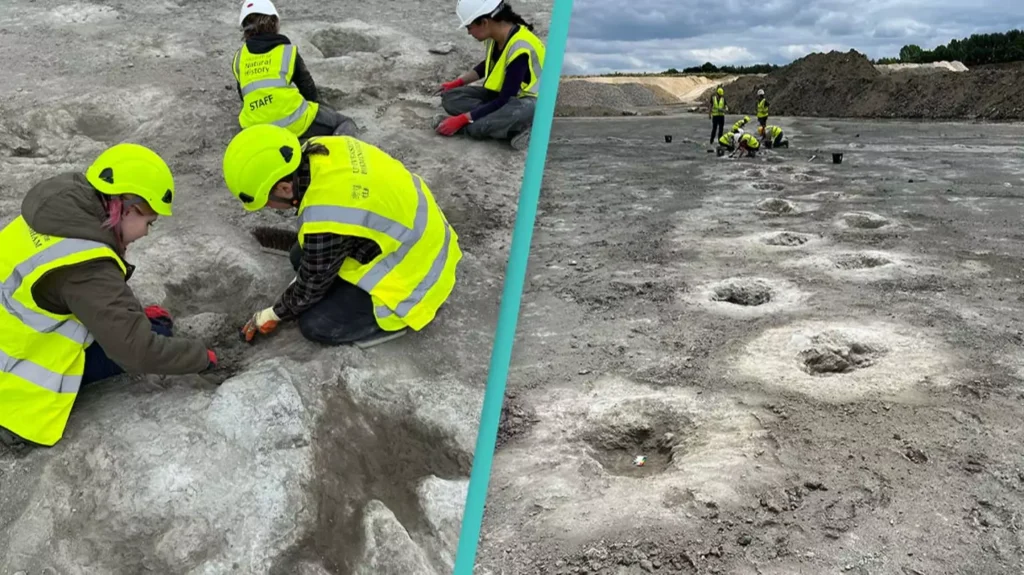Remarkable Discovery: Over 200 Pristine Jurassic-Era Footprints Discovered at Dewars Farm Quarry in Remarkable Scientific Breakthrough – A stunning glimpse Into…see…more
In an extraordinary breakthrough for paleontology, scientists have uncovered over 200 perfectly preserved Jurassic-era dinosaur footprints at Dewars Farm Quarry in Oxfordshire, England. This discovery offers a remarkable glimpse into the age of giants, transporting us back an astonishing 166 million years to a time when colossal creatures roamed the Earth.
The excavation, led by a team of renowned paleontologists from the University of Cambridge and the Natural History Museum, revealed an unparalleled array of footprints spanning various dinosaur species. The footprints, ranging from a few inches to over three feet in diameter, were found embedded in fine-grained sandstone that has withstood the test of time, preserving the intricate details of the prehistoric creatures’ movements.
Dr. Emma Harrison, the lead researcher on the project, described the find as “one of the most significant discoveries in recent decades.” “What we have here is a snapshot of life during the Middle Jurassic period. These footprints offer invaluable insights into the behavior, movement, and environment of dinosaurs,” she said during a press briefing.

The footprints are believed to have been left by sauropods, theropods, and ornithopods — three distinct groups of dinosaurs. Sauropods, known for their long necks and tails, were among the largest land animals to ever exist. Theropods, including the ancestors of modern birds, were bipedal carnivores, while ornithopods were herbivorous dinosaurs that likely traveled in herds.
The Middle Jurassic period, spanning from approximately 174 to 163 million years ago, is one of the least understood eras in dinosaur history due to the scarcity of fossil evidence. The discovery at Dewars Farm Quarry bridges a crucial gap in the paleontological record, shedding light on the diverse ecosystem that existed during this pivotal time.
Researchers have meticulously documented the footprints using 3D scanning and photogrammetry techniques. These advanced tools have enabled scientists to create highly detailed digital models of the prints, preserving their structure and allowing for further analysis without risking damage to the originals.
Preliminary findings suggest that the footprints may represent a snapshot of a moment when multiple species gathered near a water source. The spacing and orientation of the prints indicate a variety of behaviors, from walking and running to foraging and possibly even interactions between different species.
The discovery raises numerous questions about the environment and ecology of the Middle Jurassic period. What did the landscape look like? What factors influenced the migration and congregation of these dinosaurs? How did these species coexist in what was likely a dynamic and competitive ecosystem?
To answer these questions, the research team plans to conduct further studies of the surrounding rock formations and sediment layers. Early evidence suggests that the site was once part of a lush, floodplain environment, with rivers and wetlands providing ample resources for herbivores and carnivores alike.
News of the discovery has sparked widespread excitement, drawing the attention of scientists, history enthusiasts, and the general public alike. Plans are already underway to preserve the site and potentially open it for educational tours, allowing visitors to experience the wonder of this prehistoric treasure trove firsthand.
“This site has the potential to inspire a new generation of paleontologists,” said Dr. Harrison. “It’s a vivid reminder of the incredible diversity of life that once inhabited our planet and the importance of preserving our natural history.”
The discovery also underscores the importance of protecting sites like Dewars Farm Quarry, which serve as irreplaceable windows into Earth’s distant past. Conservationists are working closely with local authorities to ensure the footprints remain intact for future generations to study and admire.
As researchers continue to analyze the findings from Dewars Farm Quarry, the scientific community eagerly awaits the insights this remarkable discovery will yield. From understanding the social behaviors of dinosaurs to reconstructing ancient ecosystems, these 200 footprints are more than just impressions in stone; they are stories etched into the Earth, waiting to be told.
This groundbreaking discovery reaffirms the importance of paleontology in uncovering the mysteries of our planet’s history. With each step forward, we gain a deeper appreciation for the age of giants and the extraordinary creatures that once ruled the world.
Leave a Reply